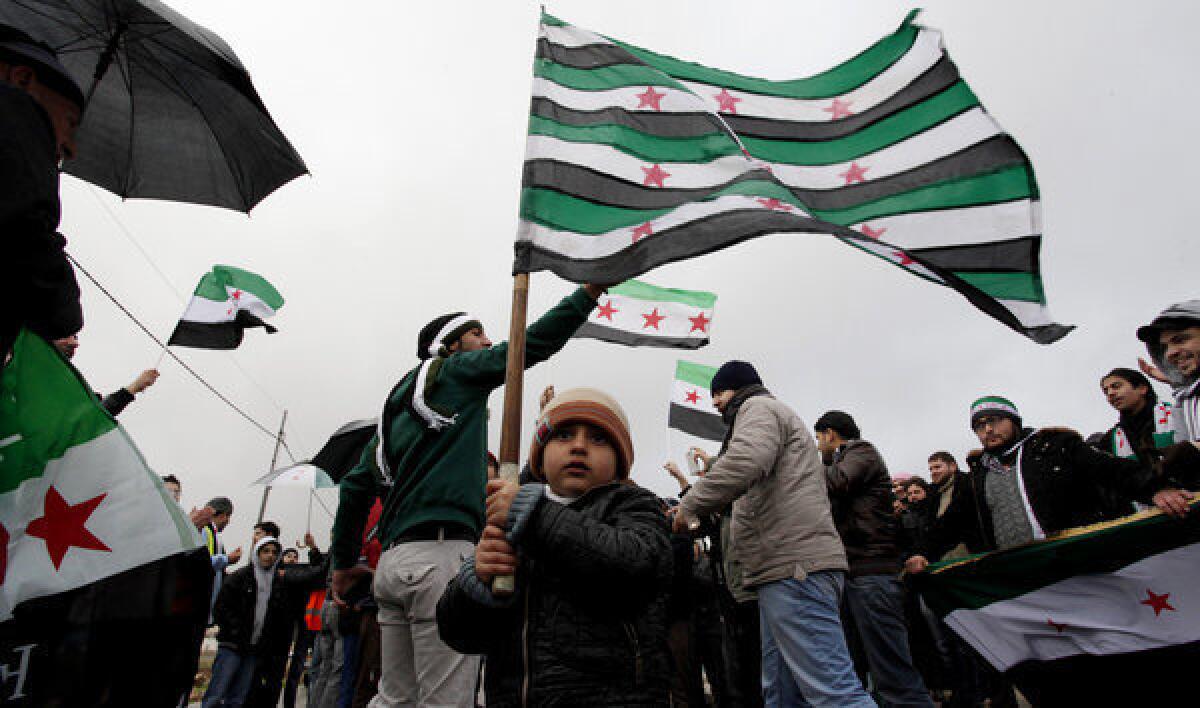Assad end may be near, but Syrian crises will continue

- Share via
Now that a consensus is forming that Syrian President Bashar Assad’s days are numbered, diplomats and Middle East experts say a troubling picture is emerging of the perils expected to confront the war-racked nation after he’s gone.
Fighting for territory around the key cities of Damascus, Aleppo and Homs has become increasingly sectarian, a U.N. special investigator reported last week, portending score-settling and revenge attacks by the dominant Sunni Muslims against Christians, Kurds, Jews and Shiite Muslims. On Monday, rebels reportedly shot down a Soviet-made fighter jet near the Alawite town of Maan, and others raised the rebel flag in the town populated by Assad’s Shiite minority sect.
Islamist groups, some aligned with Al Qaeda, have been at the forefront of successful drives to take territory and weapons from the embattled regime, boosting their clout with the newly formed shadow government and military councils poised to take over after Assad falls, flees or is killed by resurgent opponents.
A humanitarian crisis already afflicts the nation in which more than 2 million have been driven from their homes, most forced to seek makeshift shelter in less strife-torn areas of the country, and hundreds of thousands taking refuge abroad in poorly supplied camps. Hospitals and clinics have been destroyed in areas where fighting was intense and ruthless, leaving the 150,000-plus wounded without adequate treatment.
Food and medicine deliveries may be easier once the ubiquitous armed clashes abate. But depending on who controls the expected influx of aid -- especially to minority communities -- new hostilities could emerge among those who lost homes, health and loved ones to the now 21-month-old uprising.
Most disturbing, according to those who have followed the bloody course of the war, is the increasingly desperate nature of Assad’s troops as they suffer losses even in their historic strongholds. Government forces in recent days have fired Scud missiles into rebel-held areas around Aleppo, bombed a Palestinian refugee camp near Damascus and attacked civilians on roads and in bread lines. The regime has also reportedly moved chemical weapons out of storage this month, either in a menacing reminder to the outside world of its power to dramatically escalate the conflict or in preparation for a last-ditch act of terror to turn the tide of the war.
The grim outlook for any negotiated settlement was emphasized Monday after the U.N. special envoy on Syria met with Assad at the presidential palace in Damascus. Lakhdar Brahimi called the situation in Syria “worrying,” and the Syrian Arab News Agency reiterated Assad’s vow to “preserve the homeland’s sovereignty and independence,” his defiant code for the status quo.
How Assad will react as rebel forces close in on the capital and the dynasty’s Alawite communities in the mountainous coastal Latakia area has stirred fears of what were once unthinkable actions.
“One potential game-changer is Syria’s stockpile of chemical weapons. A few weeks ago, the regime seemed to be preparing these weapons for use amid fighting near Damascus,” said Jeffrey White, a 34-year veteran of the Defense Intelligence Agency and expert on Syrian military issues. “Although Assad has since backed off such activity, the international community should be prepared for the regime to use chemical weapons, whether to terrorize the population in a given area, break the link between civilians and the armed opposition, or tactically change the military situation.”
Assad’s departure is likely only weeks away, a few months at the most, White predicted. Government forces have lost the ability to carry out major offensives and are sustaining at least 1,000 fatalities a month, he said.
In contrast, the rebels have rolled up territorial gains and steadily improved their combat capabilities, acquiring what White terms “psychological dominance” that has turned the course of the war in their favor even if they too are suffering more than 800 killed in action each month.
Andrew J. Tabler, a senior fellow in Arab politics at the Washington Institute for Near East Policy, warned that the United States missed an opportunity to help shape post-Assad Syria by refusing to play a more active role in arming and advising the rebels in their quest to topple a brutal regime.
“In light of American inaction, the rebels are trending toward Islamism and anti-Western sentiment,” Tabler said.
The Al Nusra Front, branded by Washington as a terrorist organization in mid-December, has been gaining in popularity as it helps rebels seize broad swaths of key territory from the government, feeding resentment toward U.S. and other Western nations that were reluctant to send arms for fear they would end up in hostile hands. Instead, Qatar, Saudi Arabia and Turkey have gained influence by providing weapons, and Islamist-led units have in any case overrun government arms depots and made off with significant stocks of weapons and ammunition, Tabler said.
Some analysts argue that the Obama administration’s arm’s-length policy toward the Syrian opposition has been a success because Assad has been brought to the verge of collapse without direct U.S. military involvement, Tabler noted.
But given the growing authority of the Islamist-led rebel factions and the “dubious political clout” of the newly formed opposition civilian and military councils, Tabler cautioned, “those who are taking the shots against Assad today will be calling the shots once he is gone.”
ALSO:
Pro-government TV cameraman slain in Syria
U.S. designates Syria rebel group a terrorist organization
Syria forces reportedly bomb Yarmouk Palestinian refugee camp
A foreign correspondent for 25 years, Carol J. Williams traveled to and reported from more than 80 countries in Europe, Asia, the Middle East and Latin America.
More to Read
Sign up for Essential California
The most important California stories and recommendations in your inbox every morning.
You may occasionally receive promotional content from the Los Angeles Times.











